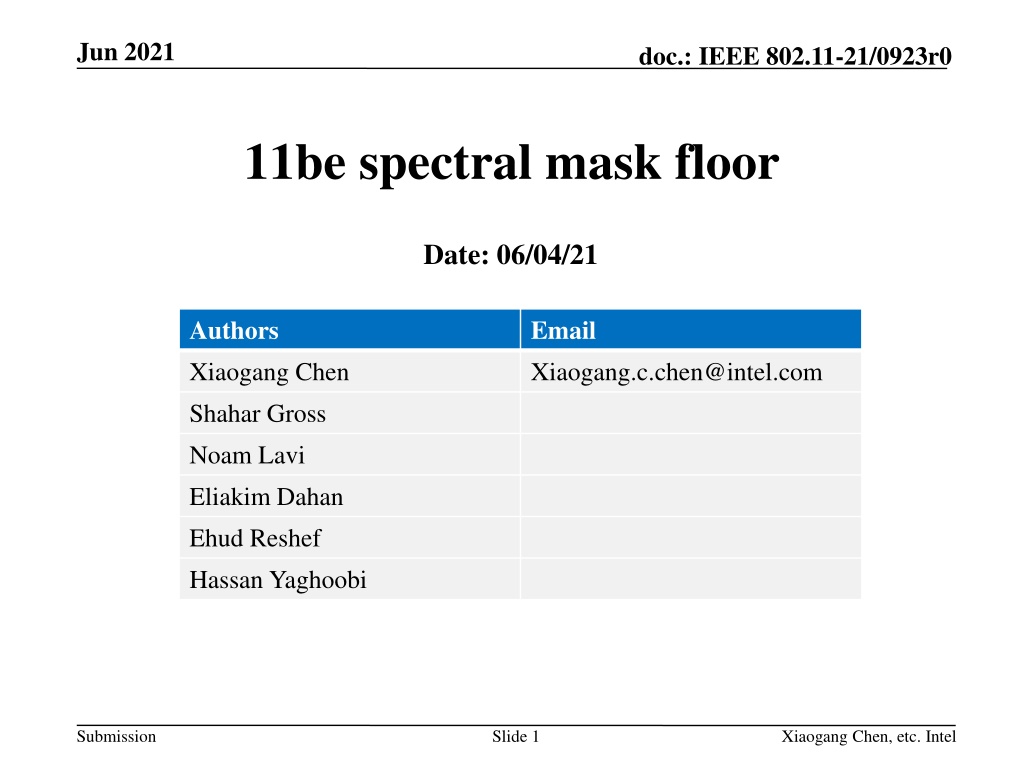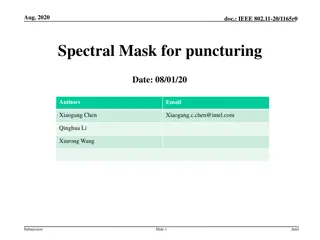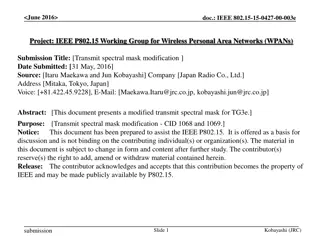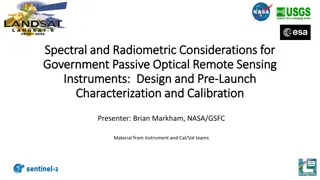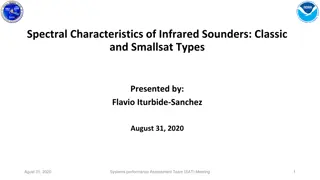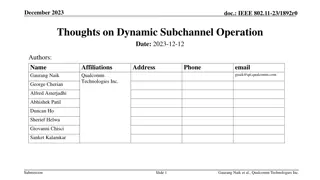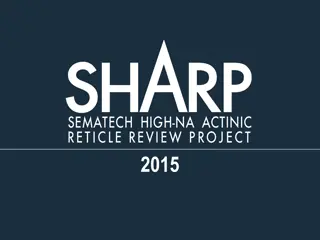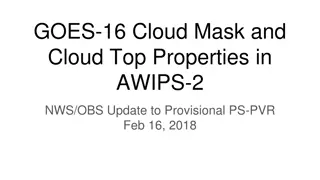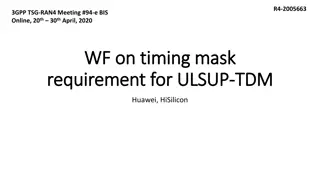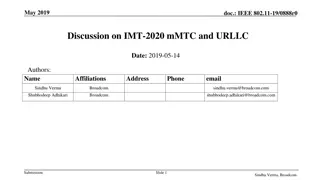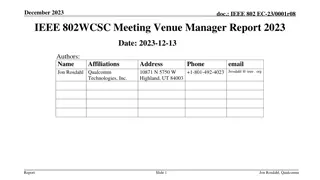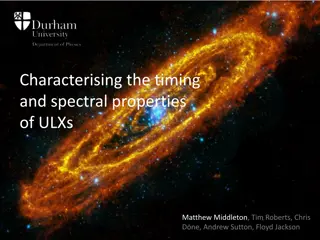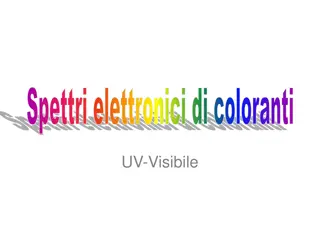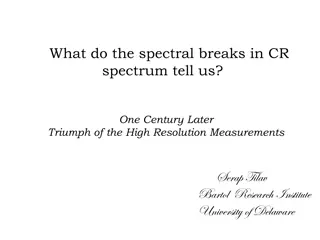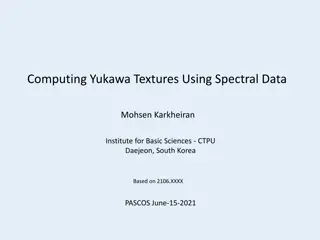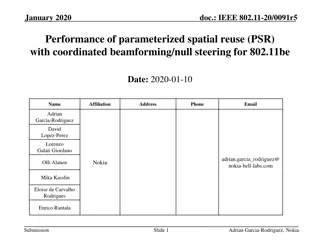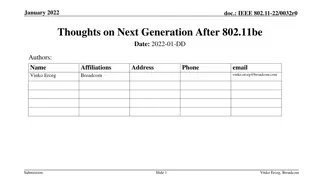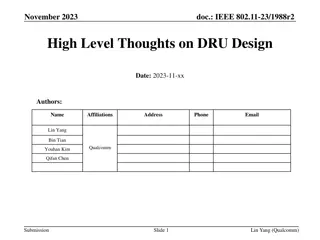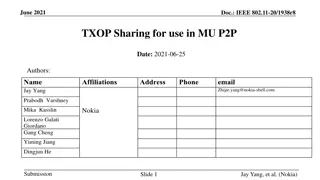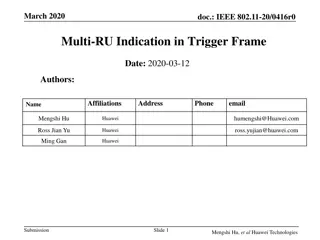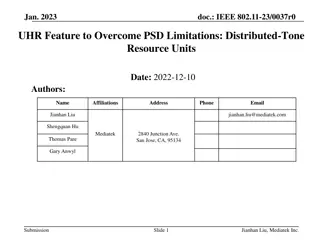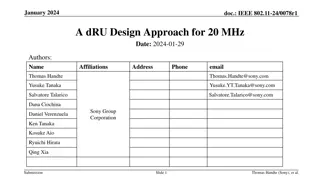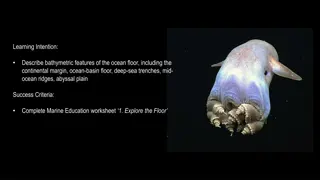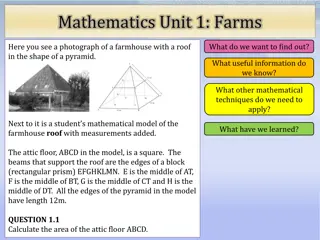IEEE 802.11-21 Spectral Mask Floor Considerations
This document discusses the considerations related to changing the absolute power spectral density (PSD) floor for IEEE 802.11-21 transmissions. It covers requirements from regulatory bodies like ETSI and FCC, as well as considerations for coexistence with technologies like 5GNR. The document also highlights specific emission limits and spectral mask requirements set by different authorities for transmitters operating within various frequency bands.
Download Presentation

Please find below an Image/Link to download the presentation.
The content on the website is provided AS IS for your information and personal use only. It may not be sold, licensed, or shared on other websites without obtaining consent from the author. Download presentation by click this link. If you encounter any issues during the download, it is possible that the publisher has removed the file from their server.
E N D
Presentation Transcript
Jun 2021 doc.: IEEE 802.11-21/0923r0 11be spectral mask floor Date: 06/04/21 Authors Xiaogang Chen Shahar Gross Noam Lavi Eliakim Dahan Ehud Reshef Hassan Yaghoobi Email Xiaogang.c.chen@intel.com Submission Slide 1 Xiaogang Chen, etc. Intel
Jun 2021 doc.: IEEE 802.11-21/0923r0 Background The transmit spectrum shall not exceed the maximum of the interim transmit spectral mask and X dBm/MHz at any frequency offset. X = -59/-56/-53dBm/MHz are too tight and may never take effect for a reasonable Tx power Abs PSD Floor (dBm/MHz) Assuming 20dBm EIRP -40dBr PSD(dBm/MHz)Tx_Pwr to reach X(dBm) -33 -36 -39 -42 -45 BW(MHz) 20 40 80 -53 -56 -59 -59 -59 0 0 0 3 6 160 320 Submission Slide 2 Intel
Jun 2021 Considerations of changing the absolute PSD floor doc.: IEEE 802.11-21/0923r0 Requirements from the regulatory; ETSI/FCC. Requirements from the peer technology; 5GNR. Coexistence. WiFi & NR; WiFi & WiFi. Submission Slide 3 Intel
Jun 2021 doc.: IEEE 802.11-21/0923r0 ETSI Note: Spurious emission is capped at -30dBm/MHz in ETSI Submission Slide 4 Intel
Jun 2021 doc.: IEEE 802.11-21/0923r0 FCC (5) For transmitters operating within the 5.925-7.125 GHz band: Any emissions outside of the 5.925-7.125 GHz band must not exceed an e.i.r.p. of 27 dBm/MHz. (6) For transmitters operating within the 5.925-7.125 GHz bands: Power spectral density must be suppressed by 20 dB at 1 MHz outside of channel edge, by 28 dB at one channel bandwidth from the channel center, and by 40 dB at one- and one-half times the channel bandwidth away from channel center. At frequencies between one megahertz outside an unlicensed device's channel edge and one channel bandwidth from the center of the channel, the limits must be linearly interpolated between 20 dB and 28 dB suppression, and at frequencies between one and one- and one-half times an unlicensed device's channel bandwidth, the limits must be linearly interpolated between 28 dB and 40 dB suppression. Emissions removed from the channel center by more than one- and one-half times the channel bandwidth must be suppressed by at least 40 dB. (7) The emission measurements shall be performed using a minimum resolution bandwidth of 1 MHz. A lower resolution bandwidth may be employed near the band edge, when necessary, provided the measured energy is integrated to show the total power over 1 MHz. Submission Slide 5 Intel
Jun 2021 doc.: IEEE 802.11-21/0923r0 3GPP_OOB Emission Instead of the general spectrum emission mask requirement in clause 6.5.2.2, when operating with shared spectrum channel access the relative power of any UE emission shall not exceed the levels specified in Table 6.5F.2.2-1 for the specified channel bandwidth or -30 dBm/MHz whichever is the greatest. Spectrum emission limit (dBr) / Channel bandwidth 20 MHz 40 MHz fOOB (MHz) 10 MHz 60 MHz 80 MHz Measurement bandwidth (MBW) [100kHz]3 1 MHz 0-1 1-5 5-10 10-20 20-30 30-40 40-50 50-60 60-70 70-80 80-100 NOTE 1: Given as: 20 8? NOTE 2: Given as: 16 12? NOTE 3: The measured value shall be scaled by a factor equal to the ratio of the reference bandwidth (1 MHz) to the measurement bandwidth before the emission limit (dBr) is applied. NOTE 4: The carrier leakage exceptions from Table 6.4F.2.3-1 apply and carrier leakage contribution shall be removed prior to setting the 0dBr level of the mask, the reported carrier frequency location in txDirectCurrentLocation field of the UplinkTxDirectCurrentBWP can be used to cancel the carrier leakage contribution. If txDirectCurrentLocation is not available or is reported with value 3300 or 3301, a carrier frequency location at the center of the channel shall be assumed. ?? ???? NOTE 1 NOTE 1 NOTE 2 -40 NOTE 1 NOTE 2 -40 NOTE 1 NOTE 2 -40 1 NOTE 1 NOTE 2 -40 NOTE 2 -40 ???? 1 where ? = ? ????????????? 2 ???? where ? = ? ????????????? 2 Submission Slide 6 Intel
Jun 2021 doc.: IEEE 802.11-21/0923r0 3GPP_Spurious emission 6.5F.3.1 General spurious emissions The requirements for general spurious emission requirements in clause 6.5.3.1 apply. -30dBm/MHz 6.5F.3.2 Spurious emissions for UE co-existence Spurious emissions requirements for UE coexistence are not applicable to bands restricted to stand-alone operation with shared spectrum channel access as identified in Table 5.2-1. For 5G network, it requires the spurious emission as low as -50dBm/MHz but not applicable to contention based channel. 6.5F.3.3 Additional spurious emissions These requirements are specified in terms of an additional spectrum emission requirement. Additional spurious emission requirements are signalled by the network to indicate that the UE shall meet an additional requirement for a Submission specific deployment scenario as part of the cell handover/broadcast message. Almost all requirements are > 30dBm/MHz; one case requires 41dBm/MHz Slide 7 Intel
Jun 2021 doc.: IEEE 802.11-21/0923r0 Summarize of comparisons FCC/5GNR ETSI/5GNR IEEE Lower than 5925MHz Within 6GHz Band (5925-7125MHz) Higher than 7125MHz -27dBm/MHz -27dBm/MHz -30dBm/MHz -30dBm/MHz -40dBr -30dBm/MHz -59dBm/MHz -59dBm/MHz -59dBm/MHz Slide 8 Intel Submission
Jun 2021 doc.: IEEE 802.11-21/0923r0 Co-existence WiFi with WiFi -40dBr 20MHz and 160MHz transmission with 23dBm Tx Power can be up to - 30dBm/MHz and -39dBm/MHz respectively AP with high Tx power has higher PSD level. Note: -39dBm/MHz = 23dBm(max EIRP_ETSI) 40dBr 10log10(160MHz). Given the -30-ish dBm/MHz bond is already exist in the current WiFi system, relax the absolute PSD floor to be -40~-30 dBm/MHz should not impact the coex between WiFi network. WiFi with non-WiFi Peer technology which sharing the same spectrum has a much-relaxed PSD requirement comparing with WiFi. The fairness issue is obvious. Submission Slide 9 Intel
Jun 2021 doc.: IEEE 802.11-21/0923r0 SP Do you agree that For the transmit spectral mask, the absolute PSD floor is defined as a fixed value of -39 dBm/MHz. This value doesn t scale with the PPDU BW. This value is applied to 5GHz and 6GHz band. Submission Slide 10 Intel
